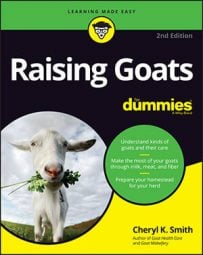If you want to breed your goats, it helps to know about goat breeding behavior. Some goats can breed or be bred when they're as young as two months old, although the majority are not fertile until four to six months old. This range arises because goats are generally seasonal breeders and don't develop heat cycles until the fall. Doe kids can usually be safely bred at seven months old — which means that they will kid at one year old — unless they are underweight or small compared with other does their age.
At the beginning of breeding season, you need to do preventive maintenance on goats to ensure that they are in optimal condition and because you may not want to handle the bucks for a while (at least not without gloves and coveralls to protect yourself from the odor, which bucks get from peeing on their legs and faces and from scent glands on the head). Perform the following chores:
Give a BoSe shot if you're in a selenium-deficient area
Trim hooves
Clip the belly hair on bucks
Test for CAEV
Do a fecal analysis and/or deworm
Handling the goats during this time gives you the opportunity to completely examine them to ensure that they don't have any problems that may affect them during breeding season.
Like many other animals, humans included, goats have their own mating rituals. The pawing, butting, snorting, and blubbering are all essential to breeding. The does play their role, and the bucks play theirs.
Goats are mostly seasonal breeders. Some of the mini breeds can be bred year-round, but their heat is most pronounced in the fall. Goats that live closer to the equator also may not have a seasonal heat but will ovulate throughout the year.
Beginning in late summer and early fall, the amount of daylight decreases, which signals the does to come into estrus (also called heat), which ends with ovulation (releasing eggs). From as early as July until January, does go into heat about every three weeks. At the beginning of breeding season some does short-cycle, which means they come back into heat in a shorter time than three weeks. Normally they cycle every 18 to 24 days thereafter, but if they continue to short cycle, you need to talk with your vet, as your doe may have a cyst on her ovary and won't conceive until she gets a drug to break the cyst.
The decreasing daylight also signals bucks to go into the male version of heat — called rut. All they can think of is breeding (sound familiar?), so they stay up late, fight, and sometimes don't eat right.
As the days get shorter, you can expect your goats to get more restless because the hormones associated with fertility kick in. Your goats will congregate along the fence line that is closest to the opposite sex and start wearing a path. During this time, you need to start planning the breedings to best fit your schedule for kidding five months after the fact.

